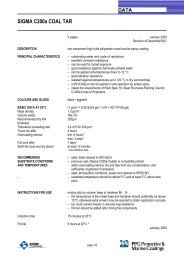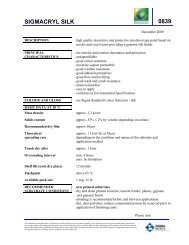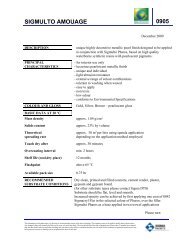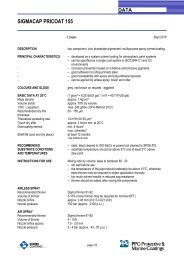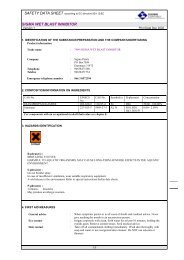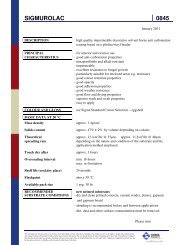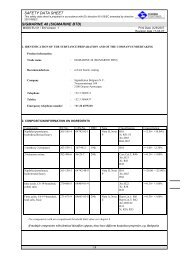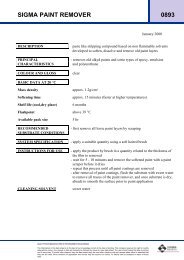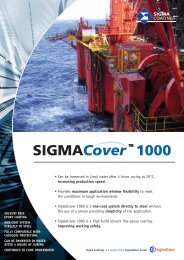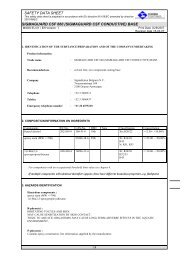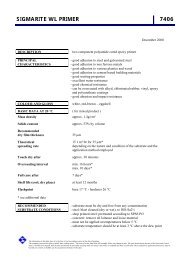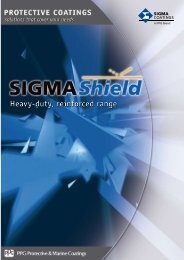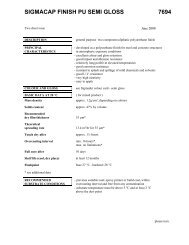Fully compatible with bioFuel StoRaGe Solvent ... - Sigma | coatings
Fully compatible with bioFuel StoRaGe Solvent ... - Sigma | coatings
Fully compatible with bioFuel StoRaGe Solvent ... - Sigma | coatings
You also want an ePaper? Increase the reach of your titles
YUMPU automatically turns print PDFs into web optimized ePapers that Google loves.
<strong>Fully</strong> <strong>compatible</strong><br />
<strong>with</strong> biofuel STORAGE<br />
solvent free<br />
phenolic epoxy<br />
no hot cure required<br />
for gasoline blends<br />
containing (bio)ethanol<br />
• NovaGuard 890 has no limitation to the amount of (bio)ethanol<br />
present gasoline blends, providing maximum storage flexibility.<br />
• No hot cure required when gasoline blends <strong>with</strong> ethanol are stored,<br />
maximum application flexibility.<br />
• NovaGuard 890 has a wide chemical resistance to crude oil up to 90°C,<br />
unleaded gasolines and biofuels providing maximum storage flexibility.<br />
• NovaGuard 890 is a one-coat system directly to steel, no primer required,<br />
reducing down-time.<br />
• NovaGuard 890 dries down to 10°C creating maximum application<br />
window flexibility.<br />
• Good filling properties making it an excellent choice for refurbishment<br />
of pitted tanks.<br />
• NovaGuard 890 can be reinforced by chopped fiber or glass laminates,<br />
which makes it full package coating for tank maintenance.<br />
• Availability in light colour makes product easy to apply in reduced<br />
visibility areas of tank.<br />
• The smooth and glossy appearance makes<br />
NovaGuard 890 easy to clean.<br />
• NovaGuard 890 is solvent free,<br />
improving working safety.
2004<br />
2005<br />
2006<br />
In the 1990’s lead was slowly banned in<br />
gasoline and regulations called for<br />
oxygenates. Most refiners started using<br />
MTBE, because it could be blended easily<br />
at the refinery. MTBE was originally added<br />
to gasoline to replace lead and meet lower<br />
aromatic hydrocarbon specifications. It<br />
also reduces carbon monoxide emissions<br />
from vehicle exhausts. However, although<br />
there is no proven health risk, if it is<br />
accidentally spilt or leaks into the ground<br />
it can taint groundwater used for drinking<br />
supplies. Therefore many countries<br />
decided to ban MTBE and the only reasonable<br />
oxygenate left to use is ethanol.<br />
Depending on the local regulation there<br />
are now gasoline’s that vary from 5%<br />
ethanol (E5) up to 95% ethanol (E95).<br />
Biodiesel and (bio)ethanol are both being<br />
captured as biofuel. Biofuel is considered<br />
an important mean of reducing greenhouse<br />
gas emissions and increasing energy<br />
security by providing a viable alternative<br />
to fossil fuels. The most common use<br />
for biofuels is in automotive transport<br />
(for example E10 fuel). Biofuel can be<br />
produced from any carbon source that<br />
can be replenished rapidly e.g. plants.<br />
Many different plants and plant-derived<br />
materials are used for biofuel manufacturing.<br />
Biodiesel is the name of a clean<br />
burning alternative fuel, produced from<br />
domestic, renewable 2004 resources. Biodiesel<br />
contains no petroleum, 2005<br />
2006 but it can be<br />
blended at any level <strong>with</strong> petroleum diesel<br />
to create a biodiesel blend. Biodiesel is<br />
simple to use, biodegradable, non-toxic,<br />
and essentially free of sulphur and<br />
aromatics. Biodiesel is produced from any<br />
fat or oil such as soybean oil, rape seed<br />
oil and palm oil, through a refinery process<br />
called transesterification.<br />
2004<br />
2006<br />
2005<br />
2004<br />
Typical grades are biodiesel B5, which<br />
is a blend of 5% fatty acid methyl ester<br />
(FAME) and conventional diesel. Also<br />
higher grades up to biodiesel B20 (20%)<br />
already exist. NovaGuard 890 is a solvent<br />
free phenolic epoxy tank lining that<br />
meets the latest chemical resistance<br />
requirements of the petrochemical industry,<br />
such as ethanol blends of gasoline<br />
and biodiesel grades. NovaGuard 890 is<br />
designed for application by standard airless<br />
spray equipment and is ideally suited<br />
for the lining of new tanks and major<br />
refurbishment of old tanks, including tank<br />
bottom repair <strong>with</strong> reinforced linings.<br />
Chemical resistance<br />
An extended chemical resistance list<br />
of NovaGuard 890 can be found in<br />
TankSelect.<br />
2006<br />
2005<br />
Typical specification<br />
• NovaGuard 890, 400 microns<br />
Typical Chemical resistance chart<br />
of NovaGuard 890<br />
Chemical<br />
Biodiesel B5<br />
Biodiesel B20<br />
Crude naphtha<br />
Crude oil<br />
Gasoline E5<br />
Gasoline E10<br />
Gasoline E15<br />
Gasoline E20<br />
Gasoline E85<br />
Heavy fuel oil<br />
Jet fuel<br />
Unleaded gasoline<br />
Resistance<br />
+<br />
+<br />
+<br />
+<br />
+<br />
+<br />
+<br />
+<br />
+<br />
+<br />
+<br />
+<br />
2004<br />
2006<br />
2005<br />
Maximum<br />
temperature<br />
(in °C)<br />
Please check our website for the latest version of<br />
the product datasheets: www.sigma<strong>coatings</strong>.com/protective<br />
90<br />
90<br />
Note*<br />
2<br />
2<br />
Excellent<br />
solvent resistance<br />
Excellent corrosion<br />
protection<br />
Resistant to chemical<br />
immersion<br />
Minimal maintenance<br />
down-time<br />
<strong>Solvent</strong>-free<br />
technology<br />
*NOTE These products may<br />
cause some discoloration of<br />
the coating. These products<br />
are variable in composition.<br />
Consequently, depending<br />
on source, the effects on<br />
the coating can also differ.<br />
Subsequent cleaning of the<br />
tanks may be difficult so that<br />
contamination of the subsequent<br />
products may occur.<br />
PPG Protective & Marine Coatings<br />
P.O. Box 58034, 1040 HA Amsterdam, The Netherlands<br />
Tel: +31 (0)20 407 5050, Fax: +31 (0)20 407 5059<br />
Email: sigma<strong>coatings</strong>.protective@ppg.com<br />
Website: www.sigma<strong>coatings</strong>.com/protective<br />
No rights can be derived from the content of this publication. Unless<br />
otherwise agreed upon in writing, all products and technical advice given<br />
are subject to our standard conditions of sale (www.sigma<strong>coatings</strong>.com).<br />
956309/01-09



